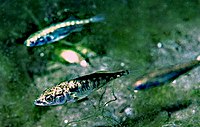
Photo from wikipedia
Predation plays a role in preventing the evolution of ever more complicated sexual displays, because such displays often increase an individual’s predation risk. Sexual selection theory, however, omits a key… Click to show full abstract
Predation plays a role in preventing the evolution of ever more complicated sexual displays, because such displays often increase an individual’s predation risk. Sexual selection theory, however, omits a key feature of predation in modeling costs to sexually selected traits: Predation is density dependent. As a result of this density dependence, predator–prey dynamics should feed back into the evolution of sexual displays, which, in turn, feeds back into predator–prey dynamics. Here, we develop both population and quantitative genetic models of sexual selection that explicitly link the evolution of sexual displays with predator–prey dynamics. Our primary result is that predation can drive eco-evolutionary cycles in sexually selected traits. We also show that mechanistically modeling the cost to sexual displays as predation leads to novel outcomes such as the maintenance of polymorphism in sexual displays and alters ecological dynamics by muting prey cycles. These results suggest predation as a potential mechanism to maintain variation in sexual displays and underscore that short-term studies of sexual display evolution may not accurately predict long-run dynamics. Further, they demonstrate that a common verbal model (that predation limits sexual displays) with widespread empirical support can result in unappreciated, complex dynamics due to the density-dependent nature of predation.
Journal Title: PLOS Biology
Year Published: 2023
Link to full text (if available)
Share on Social Media: Sign Up to like & get
recommendations!